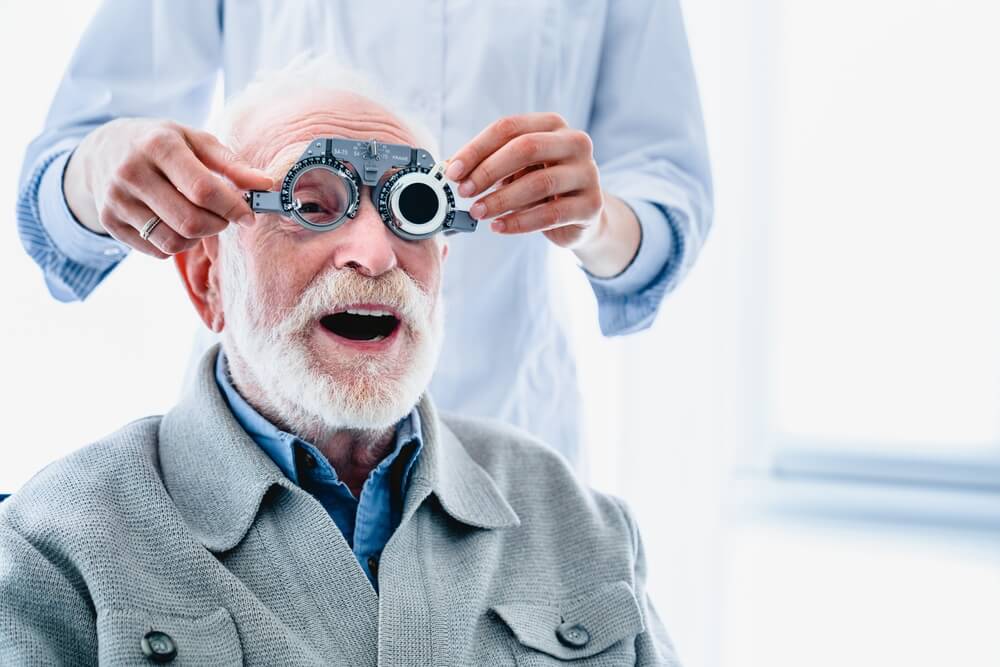Cataract surgery is one of the most common and successful procedures performed worldwide, offering patients clearer vision and improved quality of life. Clear lens exchange (CLE) surgery is exactly the same procedure, just tailored to patients 40-60 years of age that haven’t yet developed cataracts that would qualify for traditional insurance coverage. At Alvarado Eye Associates in San Diego, Dr. Lee Katzman and his team are committed to ensuring you have a smooth experience, from pre-surgery consultations to post-surgery recovery. If you’re considering cataract or clear lens exchange surgery or have already scheduled your procedure, understanding what to expect at each stage can help you feel prepared and confident. Below, we will walk you through the entire process, from before the surgery to the recovery period.
Before Cataract / Clear Lens Exchange Surgery: Preparation and Consultation
Before undergoing surgery, it’s essential to have a comprehensive eye exam and consultation with your ophthalmologist (the surgeon performing your surgery), like Dr. Lee Katzman. This initial visit will allow the doctor to evaluate the severity of your cataracts or understand your particular visual needs (in the case of CLE), in addition to assessing your overall eye health. A thorough eye examination includes tests to measure your vision, assess the condition of your retina, numerous tests to measure the cornea/ocular surface, and ensure there are no other conditions that may interfere with the surgical plan/objective.
In the weeks leading up to the procedure, you’ll be given specific instructions to follow. These instructions may include guidelines for stopping certain medications, avoiding makeup or lotions around the eyes, refraining from wearing certain contact lenses, and arranging for transportation to and from the surgery center. You may also be asked to use medicated eye drops to prepare your eyes for surgery and reduce the risk of infection, inflammation, or dry eye disease.
It’s important to discuss any concerns or questions you have during this pre-surgery consultation. Dr. Katzman will explain the procedure in detail, outline any potential risks, and discuss the different types of intraocular lenses (IOLs) available for your surgery, such as monofocal, toric, multifocal, or light adjustable lenses. This is also the time to ask about the recovery process, as you’ll want to ensure you have a support system in place after the surgery.
After you meet Dr. Katzman at your initial consultation, you will return for a pre-operative examination. At this visit, you will be run through a battery of testing to gather all the data necessary to order your custom intraocular lens. This is also a second opportunity to meet with Dr. Katzman and review your lens choices, answer last minute questions, and review your medical history and medications in preparation for your surgery day. This is a unique opportunity to meet your surgeon a second time, which oftentimes is not an option at many other eye centers.

During Cataract / Clear Lens Exchange Surgery: What Happens in the Operating Room
Cataract and CLE surgery is typically performed on an outpatient basis, meaning you’ll be able to go home the same day. The procedure is relatively quick, often taking less than 10-15 minutes to perform, however you need to plan to be in the surgical suite for 3 hours. This additional time is necessary to factor in time to complete paperwork and check-in, go to the restroom, get your intravenous line (IV) for anesthesia, and to dilate the eyes (which alone can take 45 minutes for a complete and stable dilation). Then, of course, you have the surgical prep to clean the face, the surgery itself, and then monitoring in the postoperative recovery unit before you go home. So if your stay is 3 hours or less, it’s a very efficient surgery center!
When you enter the operating room, you’ll be given an IV anesthetic by your anesthesiologist, as well as a local anesthetic to numb the area around your eye. This is considered twilight anesthesia, which means you will be able to breathe on your own without assistance. Every patient has a different preference for their anesthesia experience: some patients want to sleep through the whole thing, others enjoy watching all of the beautiful psychedelic colors. Some even have a fear of anesthesia and want zero sedation! Dr. Katzman has performed thousands of these surgeries, and can accommodate any level of anesthesia that you desire!
During the surgery, and typically using robotic laser assistance, Dr. Katzman will break up and remove the cataract or clear natural lens, and replace it with a new, clear intraocular lens (IOL) in its place. This is completed without stitches, and only takes about 10-15 minutes.
While cataract and clear lens exchange surgery is generally painless, you may feel some pressure or mild discomfort during the procedure. However, these sensations are typically brief and manageable, and Dr. Katzman will keep you updated on your progress throughout the procedure.
After Cataract / Clear Lens Exchange Surgery: Recovery and What to Expect
Once your cataract / clear lens exchange surgery is completed, you’ll be moved to a recovery area where you can rest for a short period. You will be monitored to ensure there are no complications and that you feel stable before discharge. While the recovery process is generally quick, there are some important things to keep in mind.
In the first few hours after surgery, it’s normal to experience mild discomfort, blurry vision, and sensitivity to light. You may also notice that your eye is a bit red or watery. These symptoms are typical and usually resolve within the first few days. Every single patient is instructed by Dr. Katzman to immediately go home, eat some food, and go to sleep for 3-4 hours. If you can’t sleep, lay on your couch with your eyes closed and listen to music. Immediately following the four hour mark, 99+% of patients will feel complete relief, save for a little scratchiness or irritation. You will be given a prescription for eye drops to help with healing and reduce the risk of infection or inflammation. It’s important to follow Dr. Katzman’s instructions carefully to ensure the best results.
For the first week or so after surgery, you’ll need to take precautions to protect your eye. This includes avoiding rubbing or pressing on your eye, refraining from strenuous activities, and wearing an eye shield at night to prevent accidental injury while sleeping. It’s also essential to avoid getting water in your eye, so you should refrain from swimming or using hot tubs during the recovery period. Washing your face and showering will be ok, but we do recommend administering your antibiotic drops afterwards.
Most patients notice an improvement in their vision in the first 48 hours after surgery, although it may take up to a few weeks for your vision to fully stabilize. You may need to attend follow-up appointments with Dr. Katzman to monitor your healing process and ensure everything is progressing as expected. During these visits, any residual swelling or discomfort can be addressed, and adjustments to your medication regimen can be made if necessary.

As your vision improves, you may also begin to notice brighter, more vivid colors and a reduction in glare or halos around lights, which is a common symptom associated with cataracts. The clarity of your vision may continue to improve for up to a month after the surgery.
Key Things to Keep in Mind After Cataract Surgery:
- Avoid touching or rubbing the eye, especially in the first few days.
- Use prescribed eye drops consistently to prevent infection and inflammation.
- Wear an eye shield at night for the first week after surgery.
- Refrain from strenuous activities, heavy lifting, or bending over for the first week.
- Avoid getting water in the eye (swimming, hot tubs, and showers).
- Attend follow-up appointments as directed to monitor healing.
Maintaining Your Vision After Cataract / Clear Lens Exchange Surgery
Cataract and Clear Lens Exchange surgery is one of the most successful and effective surgeries performed in the world, with most patients achieving significant improvements in their vision. In fact, the vast majority (well over 90%) of individuals who undergo cataract surgery report satisfaction with the results. Clear Lens Exchange surgery patients report over 99% satisfaction with their results. However, while both surgeries correct vision problems related to the clouding of the lens (or dysfunctioning of the lens), it doesn’t prevent other age-related vision issues from occurring later in life, such as diabetic retinopathy or macular degeneration.
After surgery, you may still need glasses for reading or for seeing at specific distances, especially if you chose a monofocal IOL that focuses on only one distance. If you want a more comprehensive solution to your vision needs, you may opt for premium IOLs, such as multifocal, toric or Light Adjustable lenses, which can reduce or eliminate the need for glasses after surgery.
It’s important to continue regular eye exams to monitor your eye health and catch any potential issues early. Maintaining a healthy lifestyle, protecting your eyes from UV radiation, and managing chronic conditions like diabetes can also help preserve your vision long-term.
Achieving Clearer Vision
Cataract and Clear Lens Exchange surgery is a safe and effective procedure that can restore your vision and improve your quality of life. At Alvarado Eye Associates, Dr. Lee Katzman and his team are dedicated to providing personalized care, ensuring that you understand each step of the process and feel confident about your recovery. If you’re considering either surgery, contact us today to schedule a consultation and take the first step toward clearer vision.
